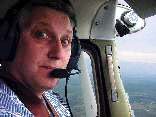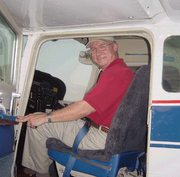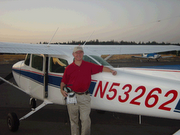Last night I had a little time on my hands so I opened the bag of parts for the electric flaps. There are lots of little parts; nut plates, bolts, angles, connectors, wire, a big dog servo and a few pages of instructions. Don't you love the minimalist approach to directions?
Anyway, I started marking some of the angles and flat aluminum. They need to be marked, drilled, cut, ground, etc before we actually start the installation.
Introduction - N9XG
We're building an RV9A together. The tail number is already reserved and is "N9XG"
It's the biggest project either of us has ever started. We're having a lot of fun and learning many things about airplane construction and about ourselves as well. This site is about the process, and our progress.
We will be updating this from time to time with progress reports. If you can't see enough detail in any of the pictures you can click on them and they will expand (like Magic).
It's the biggest project either of us has ever started. We're having a lot of fun and learning many things about airplane construction and about ourselves as well. This site is about the process, and our progress.
We will be updating this from time to time with progress reports. If you can't see enough detail in any of the pictures you can click on them and they will expand (like Magic).
Monday, September 22, 2008
Tuesday, September 16, 2008
Auto pilot selection
 This is the TruTrak ADI Pilot II.
This is the TruTrak ADI Pilot II. It is by all accounts a very cool tool. It looks like this will be in our panel.
•GPS-Slaved solid-state DG
•Digital Ground Track Selector
•GPS Nav Mode
•True Control Wheel Steering
•Altitude Hold
•Altitude adjust fro baro change
•Built-in ADI:
Bank angle is instantaneous gyro data. Pitch is gyro enhanced vertical speed. Direction is an electronic DG showing track. Extreme bank angle is enunciated by flashing red arrows which indicate required stick motion to correct unusual altitude. Low airspeed warning is enunciated by flashing A-S on the display.
•12-28 Volt only
•ADI Pilot II 3-1/8" Dimensions
3.4" H x 3.4" W x 4.7" D
•Standard weight including servo 6lb
Thursday, September 11, 2008
New QB pics

It occured to me that I have not posted any picture recently. Here are a couple shots of the quick build fuse and wings.

And a picture of Bob holding one of the wing tips.
We've been trying to decide how to do the lighting. Should we put the landing lights in the wing tips or cut out a section of the leading edge of each wing?
Still cogitating on that...
Here are a couple of solutions we've looked at:
CreatiAir
Very Nice Look
One of the advantages of LED lighting is it takes very little power to drive them. Price may be the winning factor.
As you can see these solutions are not what you could call cheap.
Empenange details - still a few to take care of
One last trip to get the correct rivets and this time's the charm Installed rivets to left elevator. As it turns out our sequence was a little off. The cherry max fit great but there was no way to get the pop rivet tool to one of the rivets, so we ended up bucking it after all.
Then fiddled with the hinge pin for the trim tab. Had to do some realigning of the hinge as it was slightly bent in the riveting mentioned above. No big deal. The hinge pin is steel and fairly stout, so putting the proper bends in the end was an imperfect operation.
After we patted each other on the back we decided to fit the fiberglass pieces to the ends of the elevators. Had to trim some of the fiberglass to get the proper fit. Band saw made short order of that. Also got an opportunity to fire up the dremmel. We proceeded to drill and cleco around the the ends. Went very well.
Then we started fitting the lead counter balance weights for the elevators. I don't know why we didn't do this stuff while we were waiting for the QB fuse and wings... Oh well. If we keep moving, we'll get there.
I continue reading about the work that's ahead of us. It's so helpful to look at some of the better builder's sites. Pictures, descriptions, solutions, creative ideas, etc. This is a great learning experience.
Then fiddled with the hinge pin for the trim tab. Had to do some realigning of the hinge as it was slightly bent in the riveting mentioned above. No big deal. The hinge pin is steel and fairly stout, so putting the proper bends in the end was an imperfect operation.
After we patted each other on the back we decided to fit the fiberglass pieces to the ends of the elevators. Had to trim some of the fiberglass to get the proper fit. Band saw made short order of that. Also got an opportunity to fire up the dremmel. We proceeded to drill and cleco around the the ends. Went very well.
Then we started fitting the lead counter balance weights for the elevators. I don't know why we didn't do this stuff while we were waiting for the QB fuse and wings... Oh well. If we keep moving, we'll get there.
I continue reading about the work that's ahead of us. It's so helpful to look at some of the better builder's sites. Pictures, descriptions, solutions, creative ideas, etc. This is a great learning experience.
Saturday, September 6, 2008
Gotta get the right rivets!
I made a special trip to Puyallup to get just a handful of cherry max rivets. It's all that's left to say "Done" to the empennage. Cherry max rivets are very specific about size, but they are the only choice for a structural pull-through rivet. I even took the parts with me to be sure I got the right rivets. The young guy minding the store seemed so sure of himself that I didn't even question him. Bad move!
I got home and it was painfully obvious that I had the wrong rivets. Lesson learned.
I got home and it was painfully obvious that I had the wrong rivets. Lesson learned.
Subscribe to:
Comments (Atom)
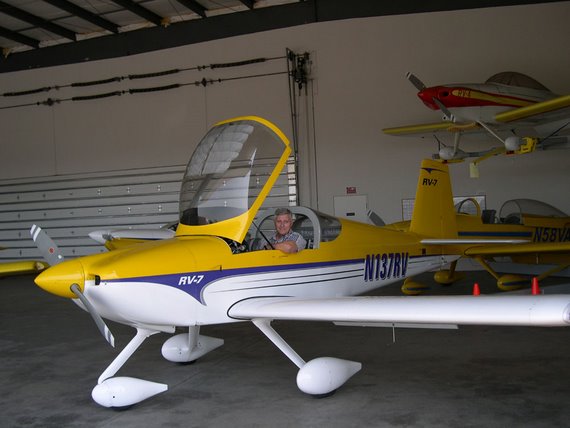
Before we decided to build an RV9A we were looking at the RV7A. This picture was taken on a factory tour.
Standard (aka Slow build) RV9a kit
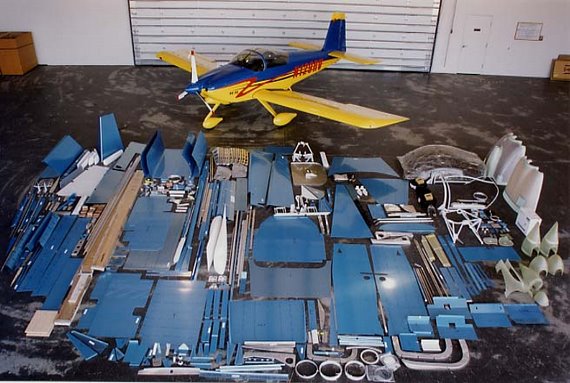
Quick build RV7 kit
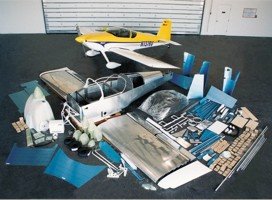
The Process
Most of us think of the airframe as the main thing, and I suppose it is; since you can't fly without it. The kits that Vans sells are match hole punched. That means that the holes are already located and punched when you get them. This saves a lot of time as you can imagine. So what follows is what you do once you've unpacked and inventoried the parts from the factory.
There are several thousands of these planes flying. Rather than making mistakes first-hand, I recommend looking at the web sites of builders who have already done this. Some of my favorite links are provided. You should also look at Van's 'Links' page for the model you're building.
Before touching the parts, it is advisable to read the instructions and review the drawings until you have a clear idea what needs to happen and what sequence it needs to happen in. The drawings are invaluable.
Each sub assembly requires the same basic process:
1. Prepare the parts for fitting. This entails cleaning, filing, and finally scotchbrighting. In addition, some parts require fabrication and/or machining.
2. Fitting is done numerous times. The pre-punched holes are matched to the corresponding part(s) and are held together with clecos.
3. Match drilling is done in assembly to provide optimum fit.
4. Once the holes are match drilled to the proper sizes, the part is disassembled and deburred to remove any sharp edges and irregularities that might result in a poor fit or the development of a crack.
5. Rivets that will be flush with the skin require either a dimple or countersinking. This is normally obvious, but sometimes the rivet needs to be flush and it's not clear at first glance just why.
6. At this point, a coat of primer and (in some cases) paint is applied protect the metal from corrosion. We've decided to prime and paint all skeletal parts; i.e. Spars, Ribs, etc. Skins will be primed where they connect. The method to our madness is this; we want defects to appear first in the skin where they are easiest to fix and pose less of a threat.
7. This is a dangerous part of the process because you might want to rivet something. But WAIT! Review the plans and the directions again.
8. Okay, so you've reviewed the plans and the parts are ready to assemble. Double and triple check the plans to ensure that the proper rivets are used. It's easy to mess this up or get out of sequence.
There are several thousands of these planes flying. Rather than making mistakes first-hand, I recommend looking at the web sites of builders who have already done this. Some of my favorite links are provided. You should also look at Van's 'Links' page for the model you're building.
Before touching the parts, it is advisable to read the instructions and review the drawings until you have a clear idea what needs to happen and what sequence it needs to happen in. The drawings are invaluable.
Each sub assembly requires the same basic process:
1. Prepare the parts for fitting. This entails cleaning, filing, and finally scotchbrighting. In addition, some parts require fabrication and/or machining.
2. Fitting is done numerous times. The pre-punched holes are matched to the corresponding part(s) and are held together with clecos.
3. Match drilling is done in assembly to provide optimum fit.
4. Once the holes are match drilled to the proper sizes, the part is disassembled and deburred to remove any sharp edges and irregularities that might result in a poor fit or the development of a crack.
5. Rivets that will be flush with the skin require either a dimple or countersinking. This is normally obvious, but sometimes the rivet needs to be flush and it's not clear at first glance just why.
6. At this point, a coat of primer and (in some cases) paint is applied protect the metal from corrosion. We've decided to prime and paint all skeletal parts; i.e. Spars, Ribs, etc. Skins will be primed where they connect. The method to our madness is this; we want defects to appear first in the skin where they are easiest to fix and pose less of a threat.
7. This is a dangerous part of the process because you might want to rivet something. But WAIT! Review the plans and the directions again.
8. Okay, so you've reviewed the plans and the parts are ready to assemble. Double and triple check the plans to ensure that the proper rivets are used. It's easy to mess this up or get out of sequence.
Rivets and Riveting
There are thousands of rivets that hold the plane together. Since this is an important task, let's talk a bit about them.
The rivets we'll be using are made of aluminium and are set in one of several ways; Hammering, Squeezing, Pull through.
Hammering a rivet is best done with a partner. One person operates the rivet gun and the other holds a bucking bar on the back side to create a shop head. I've tried doing this alone and almost always with undesirable results. The idea is for the shop head to be approx 1.5 times the diameter of the shank of the rivet.
Squeezing a rivet requires a special tool and is my preferred way whenever possible. Some folks use a manual squeezer, but I like pneumatic squeezer. They develop approx 3,000 pounds of force in the last 1/8th inch of the piston's travel. So proper adjustment is important. Once adjusted properly it will deliver consistent rivet sets.
Pull through (aka Blind or Pop) rivets are for those applications where there is no way to get access to the back side of the rivet. In general this type of rivet has inferior strength characteristics compared to a solid rivet. The noteworthy exception is the Cherry Max rivet. It is a pull through rivet, but it is also structurally rated and not cheap.
The rivets we'll be using are made of aluminium and are set in one of several ways; Hammering, Squeezing, Pull through.
Hammering a rivet is best done with a partner. One person operates the rivet gun and the other holds a bucking bar on the back side to create a shop head. I've tried doing this alone and almost always with undesirable results. The idea is for the shop head to be approx 1.5 times the diameter of the shank of the rivet.
Squeezing a rivet requires a special tool and is my preferred way whenever possible. Some folks use a manual squeezer, but I like pneumatic squeezer. They develop approx 3,000 pounds of force in the last 1/8th inch of the piston's travel. So proper adjustment is important. Once adjusted properly it will deliver consistent rivet sets.
Pull through (aka Blind or Pop) rivets are for those applications where there is no way to get access to the back side of the rivet. In general this type of rivet has inferior strength characteristics compared to a solid rivet. The noteworthy exception is the Cherry Max rivet. It is a pull through rivet, but it is also structurally rated and not cheap.
Removal
When rivets are set badly (as is sometimes the case) You need to decide if it's so bad that it just has to be replaced or is it okay as is. The main concern is to remove the offending rivet without doing damage to the hole it's in; e.g. enlarging or elongating or both.
When rivets are set badly (as is sometimes the case) You need to decide if it's so bad that it just has to be replaced or is it okay as is. The main concern is to remove the offending rivet without doing damage to the hole it's in; e.g. enlarging or elongating or both.
If it just doesn't pass muster, get a drill bit about the diameter of the rivet shaft or smaller. Center punch the head of the rivet (solid rivets only) and then carefully drill thru the head just down to where the shaft meets the hole. Once this is done, insert and old drill bit into the hole and wiggle the head until it snaps off. Once the head is off you should be able to push it out with a punch.
With pull through rivets this can be problematic, as the shaft is most likely steel and may turn with the drill bit. Another problem with removing blind rivets is this. Blind rivets are used because access to the back side is either difficult or impossible. Onc you commit to removing the blind rivet, you have to figure out how to remove the back side when you punch it thru the hole.
